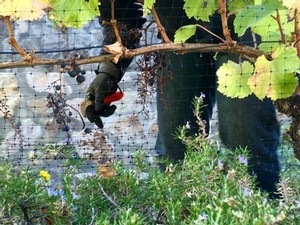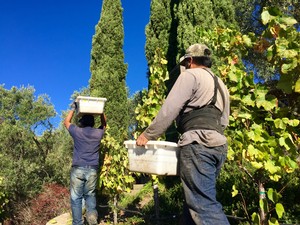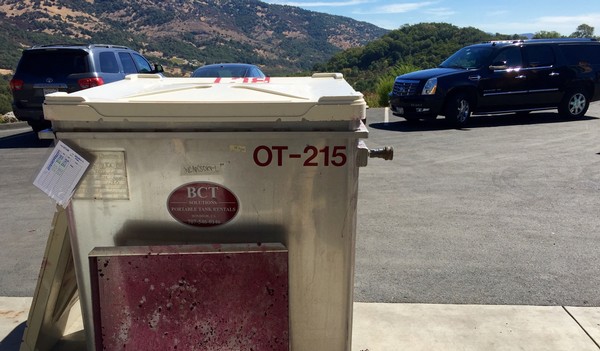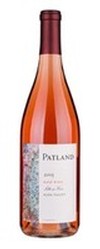Through Rosé Colored Glasses
I always say, “Good wine isn’t good wine. Different wine is good wine.” For me, the fun of wine isn’t always about how much I like whatever is in my glass, rather it’s about learning and experiencing something new. In fact, my friend and I once finished half a bottle of badly corked wine just so we’d never forget the taste! I’m not talking about corked wine right now, though. Instead, I want to talk about the Patland Rosé. I think we can all agree it is not a typical rosé.
My guests always ask me what my favorite wines are, and while my answer probably changes every month, our Rosé always seems to make it into the Top Three. Why? Because it’s so surprisingly different!
Most people when they think about rosé wine have an image in their mind of pinkish, salmon-colored wine. It’s usually light in body—almost airy, and floral on the nose. It also tends to say ‘Provence’ on the label. The reason for that is that the French invented a winemaking process specifically for rosé production called ‘Saignée’—meaning “bleed off”.
Nowadays, Saignée is a widely used method of making rosé around the world, so you’re just as likely to see a Provence-style wine in Napa as you are in France.
Before I tell you about how the Patland Rosé is made, I want to make sure you understand this Saignée process. So let’s take a few steps back… You’re standing out in your vineyard. You taste your Pinot Noir and it’s at that perfect level of ripeness, so you give the go ahead to pick it. The harvest starts early in the morning, and by noon you’ve got all of your fruit at the winery. All your grape clusters are sitting in this big, plastic container, and then you go ahead and dump them into a de-stemmer. Whole clusters go in, and berries come out. The berries are now vibrating down a sorting table, where a few people are picking out the underripe berries, the raisins, the leaves, and other non-berry objects. As the berries reach the end of the sorting table, they are then redirected into a fermentation tank.


The berries will then sit in this tank—crushing each other—for seven to fourteen days. As the fruit weighs down on itself, the berries will naturally break and start to release juice. That juice is typically the bulk of the finished wine, and it is directed into barrels for aging. The rest of the berries are put into a basket press, and the juice pressed off from there is also put into barrels for aging. Later down the line, the winemaker will taste the different barrels and decide which ones he wants to blend and how in order to make the final product.

So where does the rosé happen? It happens right after the fruit is put into the fermentation tank. You are literally ‘bleeding off’ the juice from that tank. The sooner you do it—the less time the juice has had to extract color from the skins—and the lighter the color of your rosé. (Note: The inside of red and white wine grapes look the same.) If you bleed off the juice a little later, you’ll have a darker rosé. If you do it right away, you’ll have a light-colored, Provence-style rosé.
Hopefully now that you’re clear on the classic method of rosé, we can talk about how Patland does it. Many wineries that make a Saignée style rosé are essentially using the by-product of a red wine they’re making to produce a second wine. For Patland Estate Vineyards, we actually source fruit specifically for our Rosé wine. Typically we use a blend of Syrah and Malbec, but for the sake of simplicity, let’s just pretend it’s 100% Syrah. When our fruit comes into the winery, it doesn’t get dumped into a de-stemmer. Instead, whole clusters are placed into something called a ‘Bladder Press’. A Bladder Press is called that because it essentially has a big balloon on the inside, that is slowly inflated. As the balloon expands, it applies more pressure to the whole berry clusters and pushes them against the sides of the tank. Now this entire process can happen very quickly—the clusters are pressed, the juice is released, it’s directed into a stainless steel tank. Or it can happen very slowly, in which case the juice that’s being released actually has a lot more time to intermingle with the berry skins. For the Patland rosé, this process happens very slowly, resulting in a highly extracted rosé!
 If you’ve ever had a glass of Patland Rosé, I’m sure you’ve noticed its color in the glass. It’s a very deep pinkish-red. When I say ‘extracted’ though, I don’t just mean the color. The aromas are jumping out of the glass too! You can actually smell the fruit on this wine without picking up the glass. Of course, it’s also one of the juiciest, most luscious rosés I’ve ever tasted, and you’ll taste it for a good while after you swallow too! This wine really lingers.
If you’ve ever had a glass of Patland Rosé, I’m sure you’ve noticed its color in the glass. It’s a very deep pinkish-red. When I say ‘extracted’ though, I don’t just mean the color. The aromas are jumping out of the glass too! You can actually smell the fruit on this wine without picking up the glass. Of course, it’s also one of the juiciest, most luscious rosés I’ve ever tasted, and you’ll taste it for a good while after you swallow too! This wine really lingers.
So I hope you now have a slightly better understanding for how rosé is made, and please feel free to comment if you have any questions.
Of course, I also invite you try a glass of Patland Rosé. We're just about to officially release our 2015 vintage and it is delicious! Visit our website or email me to order your wine today. Cheers!
